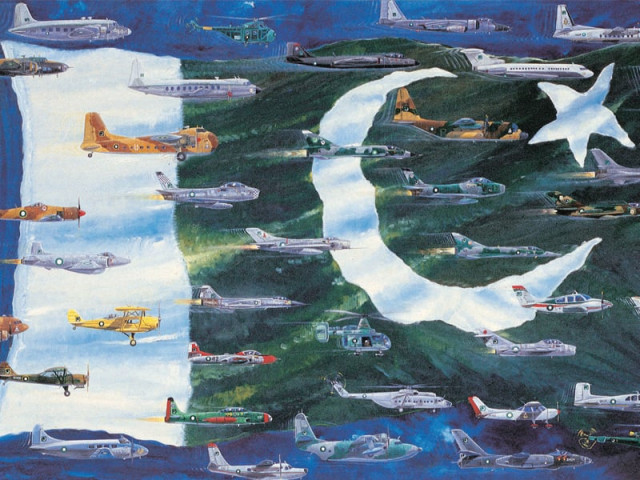The art of flying
The idea of taming the winds to soar through the skies has fascinated mankind.

Portraying the magnificence of an aircraft while at the same time conveying an impression of high speed in the backdrop of a colourful landscape or skies is a visually mesmerising form of art. Ironically, this genre actually predates man’s first flight and, over the past several decades, aviation art has truly evolved.
In South Asia and the Middle East, the most work in this field has been done in Pakistan. However, since aviation is still relatively limited, the most exciting artwork has inevitably focused on the Pakistan Air Force (PAF) and its many historic escapades. Recognising the potential of such visual treats, the PAF extends support to aviation artists. After all, the real art of flying lies in the natural flair of drawing an aircraft in its splendour rather than the technical precision required to control it in the air.
Some of the best works from Pakistan’s self-taught aviation art prodigies are presented here.
©Syed Masood Akhter Hussaini.
On the evening of 6 September 1965 No. 19 Squadron of PAF lead by Sqn Ldr Sajad Haider Sitara-e-Jurat wreaked havoc on the IAF base of Pathankot, destroying 14 IAF aircraft. This historic mission is depicted by Group Capt Hussaini in vivid detail based upon accounts of the pilots who participated in the attack. The painting has graced many books on the history of Indo-Pak conflicts. Most recently the cover of Air Cdre (Retd) Sajad Haider's highly acclaimed memoir Flight of the Falcon. This painting hangs at the HQ Air Defence Command.
©Syed Masood Akhtar Hussaini.
A painting which remains one of the most recognised posters ever made in Pakistan. In 1997, marking the 50th anniversary of Pakistan and the PAF, Group Capt Hussaini painted all the aircraft ever operated by the PAF from 1947 till 1997 against the backdrop of the Pakistan flag. The painting hangs at the National Defence University, Islamabad.
© Sqn Ldr Rehan Siraj/PAF
PAF finally succeeded in developing its own fighter aircraft in collaboration with China and the JF-17 'Thunder' joined the PAF fleet last year. This painting celebrates the milestone accomplishment in Pakistani aviation and depicts a JF-17 taking off from a northern base with the Pakistan flag reflecting in the sky.
©Syed Masood Akhter Hussaini.
On the first night of the 1965 Indo-Pak war, a valiant B-57 bomber pilot Squadron Leader Shabbir Alam Siddiqui and navigator Squadron Leader Aslam Qureshi flew into enemy airspace for the third time within a span of 9 hours, creating a war-time record. After having successfully completed two bombing missions and returning home safely, the crew volunteered to fill in for another pilot who backed out from his mission and took off yet again at 0335 Hrs on the morning of 7 September 1965, never to return.
On their third mission the B-57 was lost and the fate of the crew remained a mystery leaving them undecorated for their exemplary valour despite their supreme sacrifice. Four decades later Sqn Ldr Alam Siddiqui's wife approached the Indian Air Force for details and closure. What followed was a historic episode of camaraderie-in-arms when the IAF informed her that her husband's aircraft was hit by anti-aircraft fire and crashed near IAF Base Jamnagar and invited her to visit the site for closure.
The painting visualises the last moments of the fateful B-57 bomber from Masroor Base Karachi after it was fatally damaged and was painted by Group Capt Hussaini as a tribute to these two unsung heroes of the PAF who sacrificed their lives on the very first day of war leaving a legacy of dedication beyond the call of duty which remains a hallmark of the PAF.
©Syed Masood Akhter Hussaini.
Sqn Ldr Jamal A Khan, later Air Chief Marshal and PAF Chief, shoots down an IAF Canberra bomber intruding into Pakistani air space at night during the 1965 war. Displayed at PAF Academy Risalpur.
©Syed Masood Akhter Hussaini.
Soon after partition,as Muslims thronged to their new homeland of Pakistan in over-crowded trains, buses, on foot and by bullock cart under fear of rioters, two Army Air Corps Auster AOP aircraft patrol over the refugee caravans to ensure their safety. It is displayed at the HQ Army Aviation Command.
Published in The Express Tribune, Sunday Magazine, August 14th, 2011.



















COMMENTS
Comments are moderated and generally will be posted if they are on-topic and not abusive.
For more information, please see our Comments FAQ